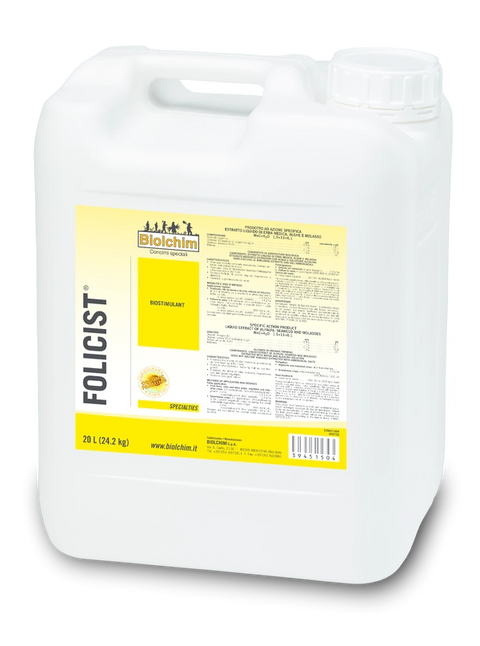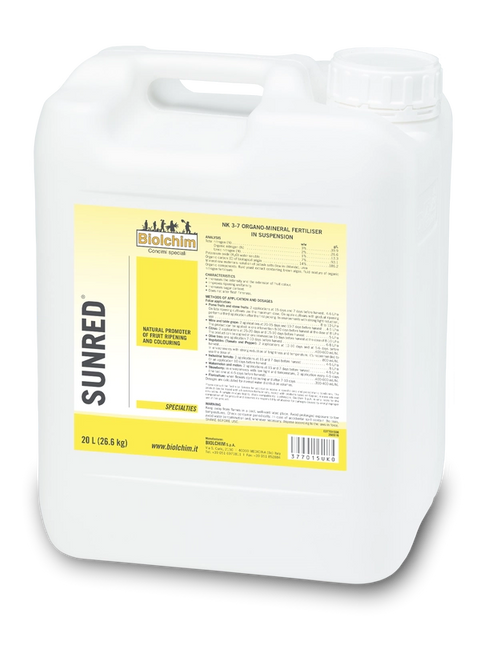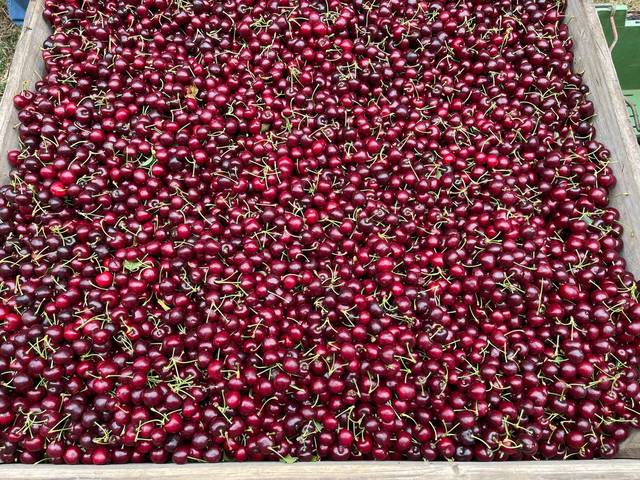
Lapin cherries - Precision ripening drives premium yield in Southern Victoria, 2019
SUNRED and FOLICIST sprays for precision ripening significantly improved quality and yield of Lapin cherries
Richard Hall, 24 December 2019
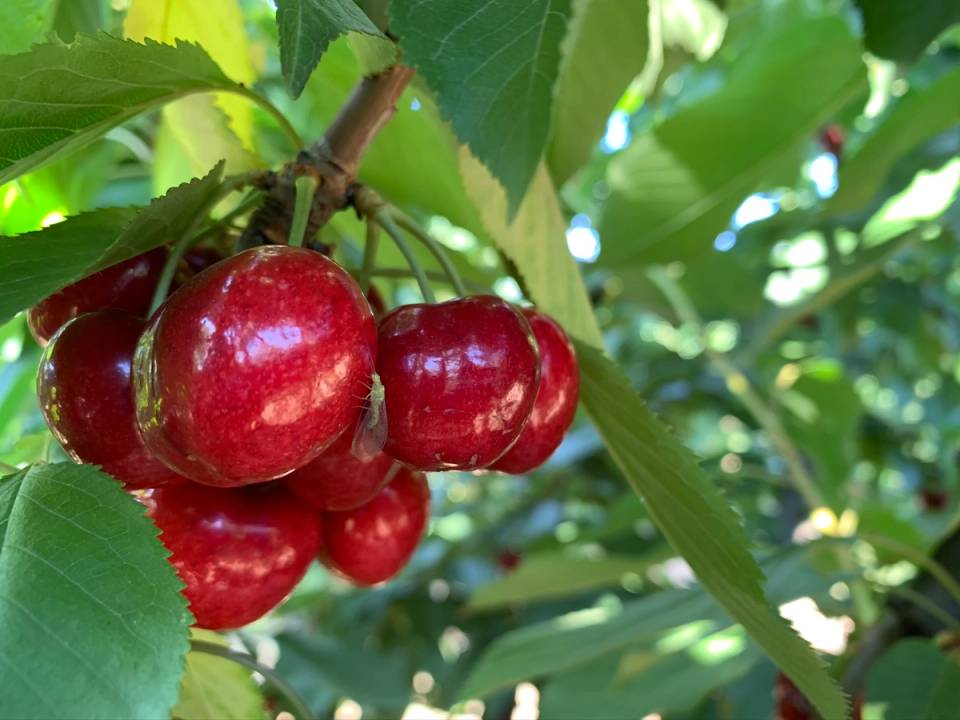
Summary
Two pre-harvest sprays of SUNRED and FOLICIST significantly (p<0.001) improved fruit diameter and yield of premium size Lapin cherries.
This case study combines results from 2 blocks in Southern Victoria at commercial harvest 24 December 2019.
In addition to significantly increased cherry diameter, Treated cherries had a more favourable chemistry profile including +25% anthocyanins. Anthocyanins are responsible for fruit colour and are powerful antioxidants.
Pre-harvest SUNRED and FOLICIST sprays are a valuable precision ripening tool.
With precision ripening comes significant yield gains in premium fruit - uniform colour, size and maturity.
It is recommended to include 2 pre-harvest sprays of a SUNRED and FOLICIST tank-mix per the Cherry Program.
For more information, to discuss specific blocks or place an order, contact Richard Hall 0413 182 763.
- +1.3mm average cherry diameter
- 2x premium size cherries (>28mm)
- +11% average cherry weight
- +25% anthocyanin (colour)
Materials and Methods
Trial design and treatments
Trial design was determined and implemented by the grower.
Applications of SUNRED and FOLICIST were made with commercial equipment across a number of rows in the blocks. Other rows were left unsprayed.
These results are across 2 blocks in Southern Victoria harvested 24 December 2019.
Grower Standard in this case was an untreated control - no precision ripening sprays were applied.
Grower standard (untreated control)
Grower standard (untreated control)
Application rates and timing were made per the BUD Biological Cherry Program.
Sampling
Sampling was conducted on the same day as commercial harvest 24 December 2019.
300 cherries were sampled in total (150 per treatment).
Cherry caliper measurements
The Feret diameter (widest point) of 300 cherries was measured using hand calipers.
Results and Discussion
Results - fruit diameter
- 2x premium size cherries (>28mm)
Per standard commercial practice, calipers were used to measure cherry diameter at the widest point. This is known as the Feret diameter.
Figure 1 shows the yield distribution of cherry diameter (fruit size) across the SUNRED and FOLICIST Treated and Standard cherries.
Note the similarities in the shape of fruit size distribution across both Standard and Treated fruit. Treated cherries show improved fruit size uniformity, less small fruit, resulting in significantly larger cherries on average.
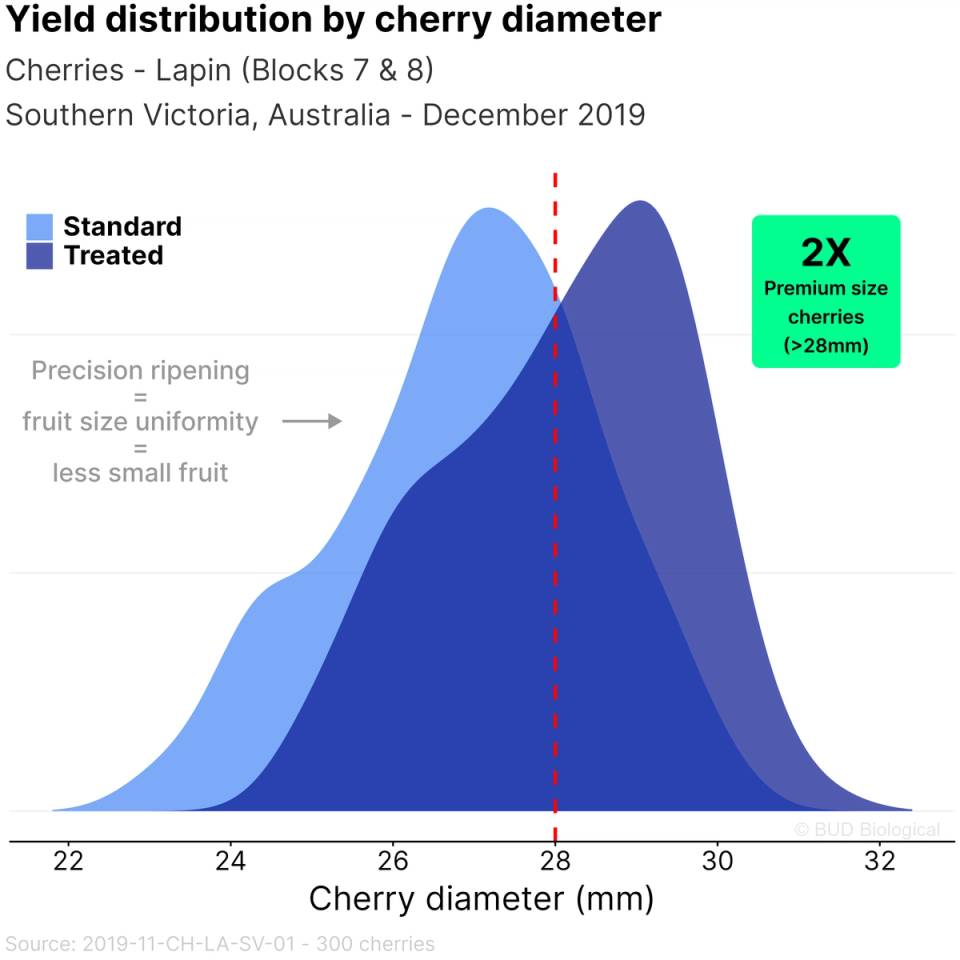
Figure 1: Yield distribution plots of cherry diameter (mm) at harvest as measured by calipers. Note corresponding peaks in the SUNRED and FOLICIST Treated and the grower Standard.
Note these precision ripening sprays were made in the pre-harvest period as cherries were changing from straw coloured to red.
Influencing cell division and increasing the number of cells per cherry is the most effective and efficient way of producing significantly larger, firmer cherries. We have other options for this, refer the Cherry Program.
Pre-harvest sprays of SUNRED and FOLICIST are not aimed at influencing cell division.
SUNRED and FOLICIST sprays pre-harvest are aimed at precision ripening of our crop.
A cherry harvested at optimal ripeness is also at optimal size.
There will be a ceiling on the size of cherries in a given block given genetics, cell number per cherry and environmental factors.
With precision ripening we improve uniformity of fruit maturity, hence uniformity of fruit size.
Improving fruit size uniformity delivers us 'larger' cherries as we have optimal maturity and optimal fruit size (less small fruit) come harvest.
Oxylipins present in SUNRED are one key component delivering us uniform fruit ripening.
In Figure 2 we see the same fruit graded into bins according to diameter.
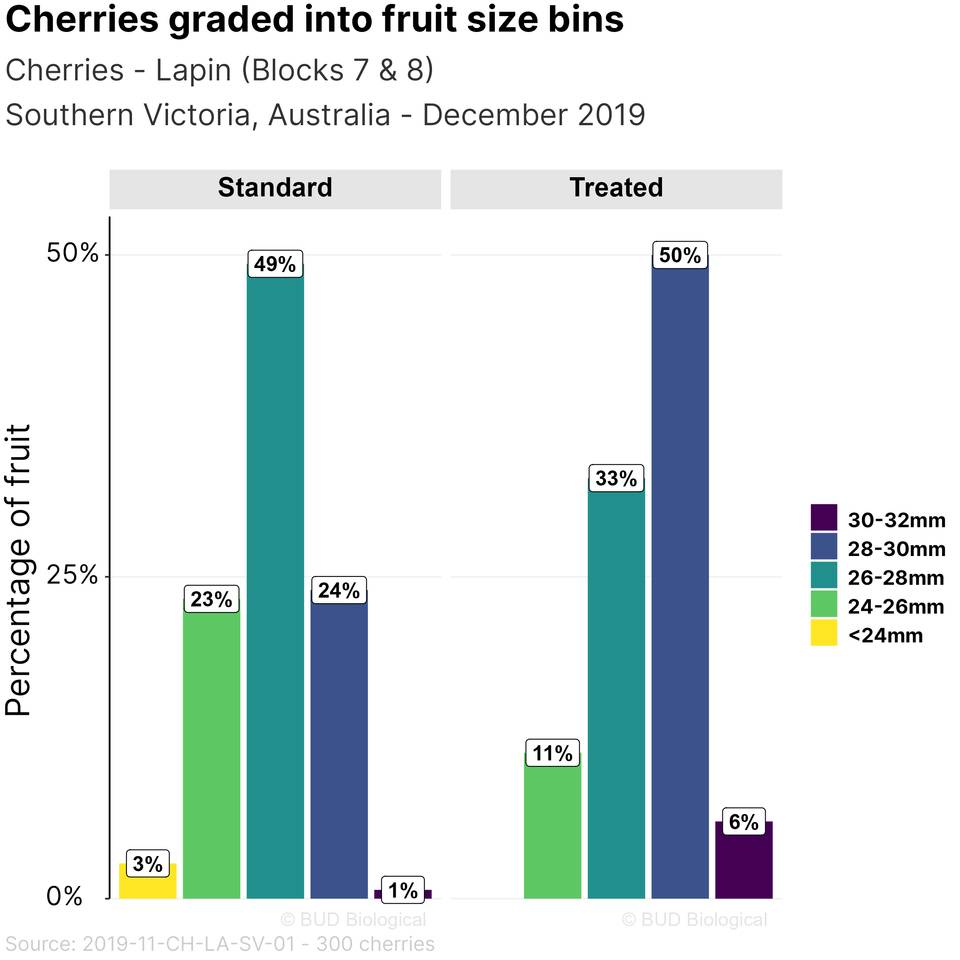
Figure 2: Percentage of fruit harvested graded into bins according to cherry diameter (mm). Note improvement in fruit size uniformity resulting in more than 2x increased percentage of premium size cherries >28mm (56% Treated compared to 25% Standard).
In Figure 3 we simplify the number of bins based on premium size fruit as either above or below 28 mm.
Note the 2x increase in cherries larger than 28 mm.
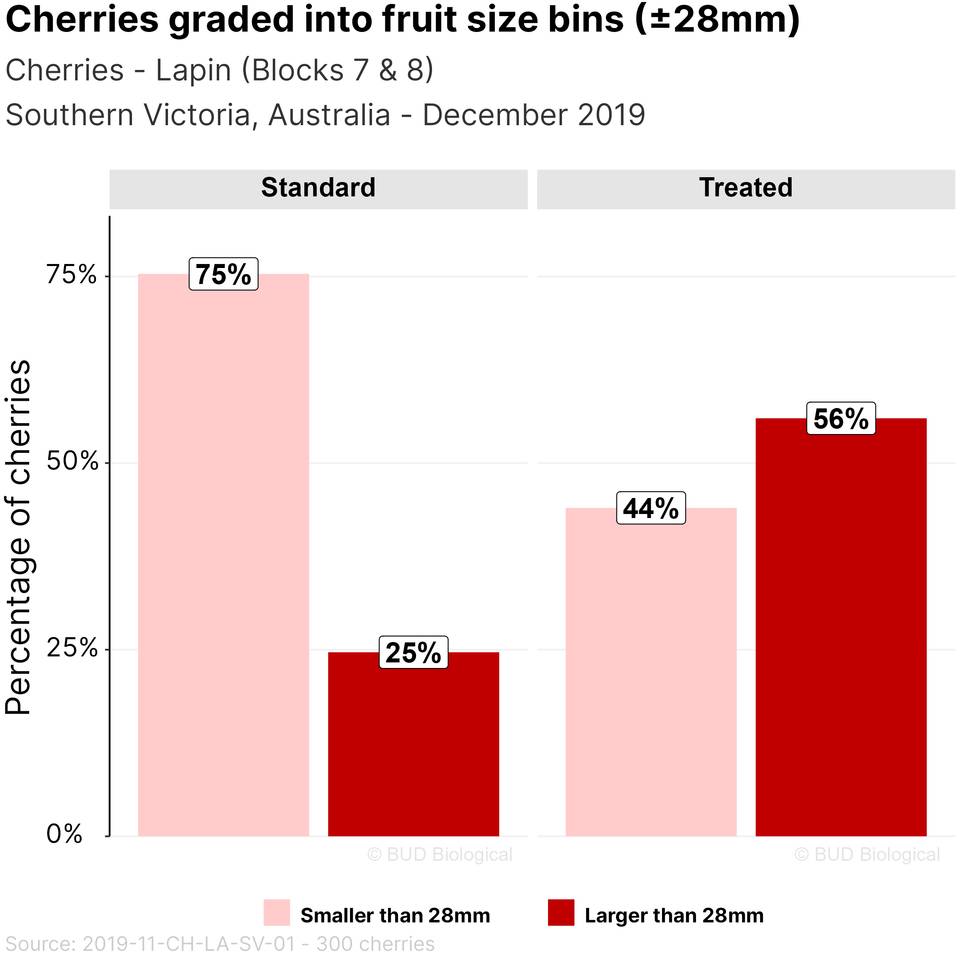
Figure 3: Percentage of fruit harvested graded into bins either above or below 28mm cherry diameter. Note improvement in fruit size uniformity resulting in more than 2x increased percentage of premium size cherries >28mm (56% Treated compared to 25% Standard).
Table 1 summarises the average (mean), standard deviation (SD) and statistics comparing Standard and Treated cherries.
Note the Treated cherries were 1.3mm larger on average which is a difference of +4.7% diameter.

Table 1: Summary table showing SUNRED and FOLICIST Treated cherries averaged 28.10 mm Feret diameter being significantly larger (1.3 mm) than Standard cherries 26.85 mm. N = 2 blocks; 300 cherries, p<0.001
Individual cherries were not weighed for this study although average cherry weights were as follows:
Standard cherry weight on average 9.11g
Treated cherry weight on average 10.11g (+11%)
Results - laboratory analysis
SUNRED, as the name suggests, increases colour.
These cherry samples were sent to a laboratory for analysis of key chemistry attributes of fruit maturity, seeds removed. Refer Table 2.

Table 2: Chemistry analysis of Lapin cherries. Note SUNRED and FOLICIST Treated cherries were slightly higher in Baume / Brix and retained higher Titratable Acidity. Epicatechin is below detection in Treated fruit indicating more complete ripeness. Total anthocyanins (colour) +25% in Treated fruit is consistent with results from other research.
Note slightly higher Baume / Brix in the Treated sample along with higher acid retention as measured by Titratable Acidity.
Key indicator of optimal maturity is the Tannin (epicatechin eq.) <5 mg/L which is less than detectable for this analysis.
Epicatechin declines sharply as fruit ripens, it is an intermediate building block of larger phenolic compounds.
Think of pallets of bricks arriving in preparation for building the house. At harvest time we don't want pallets of bricks laying around, we want the house to be built.
In the Standard sample, Tannin (epicatechin eq.) is 60 mg/L indicating this fruit was not optimally ripe.
Note also the +25% increase in anthocyanins in Treated cherries.
Anthocyanins are not only responsible for colour but also powerful antioxidants and a significant promotional point for the health benefits of cherries and the 'super' fruit story.
Through this and related research we've discovered that we cannot achieve optimal yield without optimal colour.
Conclusions
Pre-harvest SUNRED and FOLICIST sprays are a valuable precision ripening tool.
With precision ripening comes significant yield gains in premium fruit - colour, uniform maturity and size uniformity.
It is recommended to include 2 pre-harvest sprays of a SUNRED and FOLICIST tank-mix per the Cherry Program.
Acknowledgements
Thank you to the grower and managers involved for only spraying a part of these blocks and excellent communication during a particularly busy time of year.
Statistics
For those who are interested
Raw data from caliper measurements of 300 cherries. Note outliers tagged were included in the tabulated data although removed from plots for purposes on focusing on the main crop. Including or excluding these outliers doesn't change the outcome.
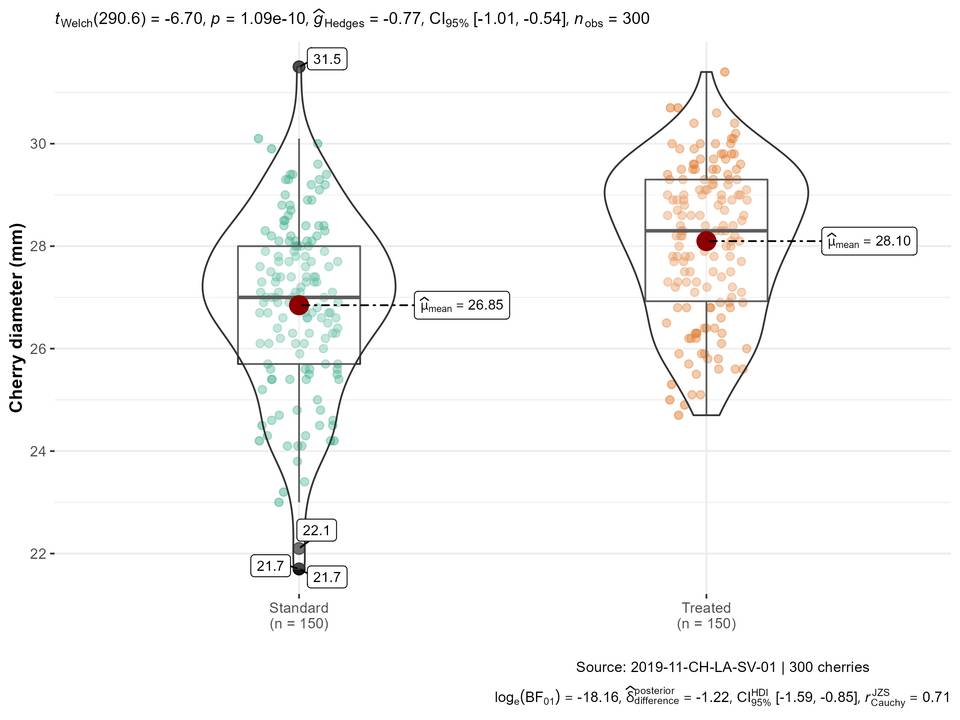
Figure 4: Statistical output from exploratory data analysis. Note outliers tagged, these don't change outcomes of analysis here.
Related Resources

